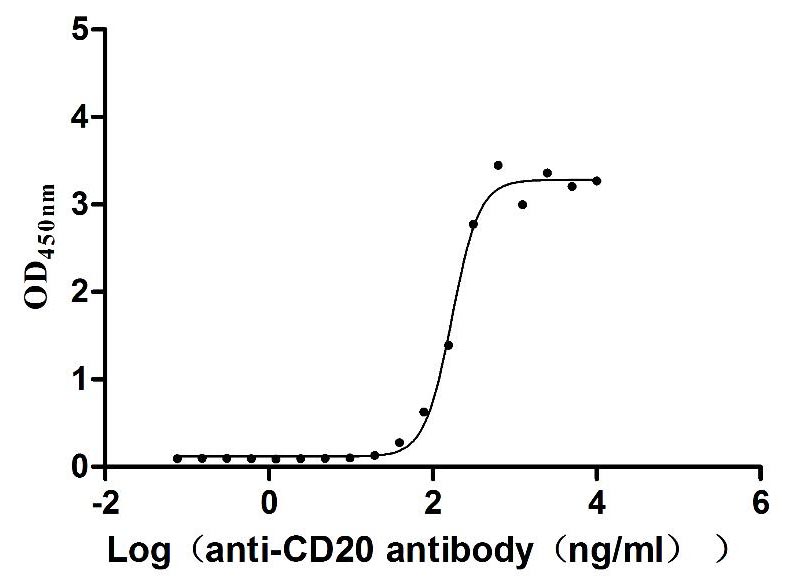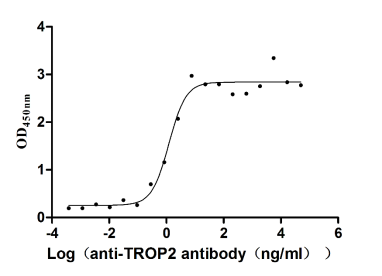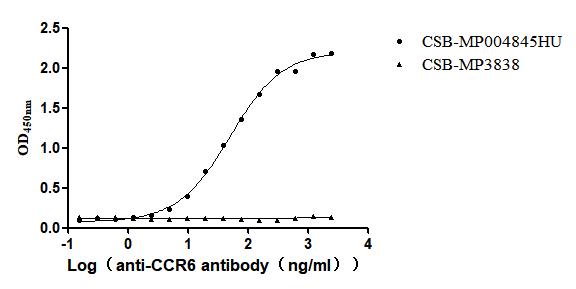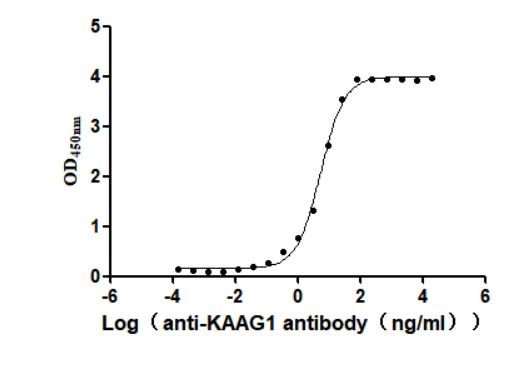Recombinant Mouse Ectonucleotide pyrophosphatase/phosphodiesterase family member 1 (Enpp1), partial
In Stock-
中文名称:小鼠Enpp1重组蛋白
-
货号:CSB-EP007679MO
-
规格:¥2328
-
图片:
-
其他:
产品详情
-
纯度:Greater than 90% as determined by SDS-PAGE.
-
基因名:
-
Uniprot No.:
-
种属:Mus musculus (Mouse)
-
蛋白长度:Partial
-
来源:E.coli
-
分子量:37.8 kDa
-
表达区域:635-906aa
-
氨基酸序列HMTVPYGRPRILLKQHHVCLLQQQQFLTGYSLDLLMPLWASYTFLRNDQFSRDDFSNCLYQDLRIPLSPVHKCSYYKSNSKLSYGFLTPPRLNRVSNHIYSEALLTSNIVPMYQSFQVIWHYLHDTLLQRYAHERNGINVVSGPVFDFDYDGRYDSLEILKQNSRVIRSQEILIPTHFFIVLTSCKQLSETPLECSALESSAYILPHRPDNIESCTHGKRESSWVEELLTLHRARVTDVELITGLSFYQDRQESVSELLRLKTHLPIFSQED
Note: The complete sequence including tag sequence, target protein sequence and linker sequence could be provided upon request. -
蛋白标签:N-terminal 6xHis-tagged
-
产品提供形式:Liquid or Lyophilized powder
Note: We will preferentially ship the format that we have in stock, however, if you have any special requirement for the format, please remark your requirement when placing the order, we will prepare according to your demand. -
缓冲液:If the delivery form is liquid, the default storage buffer is Tris/PBS-based buffer, 5%-50% glycerol. If the delivery form is lyophilized powder, the buffer before lyophilization is Tris/PBS-based buffer, 6% Trehalose.
-
复溶:We recommend that this vial be briefly centrifuged prior to opening to bring the contents to the bottom. Please reconstitute protein in deionized sterile water to a concentration of 0.1-1.0 mg/mL.We recommend to add 5-50% of glycerol (final concentration) and aliquot for long-term storage at -20℃/-80℃. Our default final concentration of glycerol is 50%. Customers could use it as reference.
-
储存条件:Store at -20°C/-80°C upon receipt, aliquoting is necessary for mutiple use. Avoid repeated freeze-thaw cycles.
-
保质期:The shelf life is related to many factors, storage state, buffer ingredients, storage temperature and the stability of the protein itself.
Generally, the shelf life of liquid form is 6 months at -20°C/-80°C. The shelf life of lyophilized form is 12 months at -20°C/-80°C. -
货期:3-7 business days
-
注意事项:Repeated freezing and thawing is not recommended. Store working aliquots at 4°C for up to one week.
-
Datasheet & COA:Please contact us to get it.
相关产品
靶点详情
-
功能:Nucleotide pyrophosphatase that generates diphosphate (PPi) and functions in bone mineralization and soft tissue calcification by regulating pyrophosphate levels. PPi inhibits bone mineralization and soft tissue calcification by binding to nascent hydroxyapatite crystals, thereby preventing further growth of these crystals. Preferentially hydrolyzes ATP, but can also hydrolyze other nucleoside 5' triphosphates such as GTP, CTP, TTP and UTP to their corresponding monophosphates with release of pyrophosphate and diadenosine polyphosphates, and also 3',5'-cAMP to AMP. May also be involved in the regulation of the availability of nucleotide sugars in the endoplasmic reticulum and Golgi, and the regulation of purinergic signaling. Inhibits ectopic joint calcification and maintains articular chondrocytes by repressing hedgehog signaling; it is however unclear whether hedgehog inhibition is direct or indirect. Appears to modulate insulin sensitivity. Also involved in melanogenesis. Also able to hydrolyze 2'-3'-cGAMP (cyclic GMP-AMP), a second messenger that activates TMEM173/STING and triggers type-I interferon production. 2'-3'-cGAMP degradation takes place in the lumen or extracellular space, and not in the cytosol where it is produced; the role of 2'-3'-cGAMP hydrolysis is therefore unclear. Not able to hydrolyze the 2'-3'-cGAMP linkage isomer 3'-3'-cGAMP.
-
基因功能参考文献:
- Runt-related transcription factor 2 (Runx2) was confirmed to have synergistic effects with Osx in activating ENPP1 promoter. PMID: 30047979
- Report the temporal ectopic mineralization phenotype of connective tissues in Enpp1asj-2J mouse model for generalized arterial calcification of infancy. PMID: 27863377
- Evidence of a causative link between ENPP1 and alterations in insulin signaling, glucose uptake, and lipid metabolism in subcutaneous abdominal Adipose tissue of gestational diabetes, which may mediate insulin resistance and hyperglycemia in Gestational diabetes. PMID: 28080219
- Results show that urine pyrophosphate (PPI) levels are increased in Npt2a-/- mice when compared to WT, possibly to protect from renal mineralization in the setting of hyperphosphaturia. However, the presence of two hypomorphic Enpp1asj/asj alleles decreases urine PPi and worsens renal calcium phosphate deposit formation in Npt2a-/- mice. PMID: 28704395
- Enpp1asj mutant mouse provides a new animal model for studying tympanosclerotic otitis and otitis media with effusion PMID: 27959908
- identified ectonucleotide pyrophosphatase/phosphodiesterase 1 (ENPP1) as the first known mammalian enzyme lacking a NUDIX domain to generate pR from ADP-ribose on modified proteins in vitro PMID: 27406238
- Vitamin D3 regulates Enpp1 expression, which presumably, in the context of adequate tissue non-specific alkaline phosphatase activity, provides phosphate to stimulate mineralisation. PMID: 26054750
- ENPP1-Fc fusion protein prevents the mortality, vascular calcifications and sequela of disease in mouse models of generalized arterial calcification of infancy. PMID: 26624227
- Expression of NPP1 and 5'-nucleotidase by valve interstitial cells promotes the mineralization of the aortic valve through A2aR and a cAMP/PKA/CREB pathway. PMID: 25644539
- Increased NPP1 expression and activity might contribute to the decreased mineralisation observed when osteoblasts are exposed to acid conditions. PMID: 26033523
- NPP1 has a role in obesity and diabetes in a mouse model PMID: 25368121
- we have characterized the phenotypic and histopathologic features of this spontaneous mutant mouse, designated as asj-2J, and we have identified a large deletion/insertion mutation in the Enpp1 gene PMID: 25479107
- these data highlight the key role of NPP1 in regulating calcification of both soft and skeletal tissues. PMID: 25260930
- ENPP1 2'3'-cGAMP-hydrolyzing activity is repsonsible for tumor progression in humans and mice. PMID: 25344812
- Both mono-allelic and bi-allelic ENPP1 deficiency promote dysregulated VSMC function, with robust C/EBP homologous protein expression and enhanced neointimal hyperplasia after injury in vivo, but marked post-injury calcification limited to Enpp1-/- mice. PMID: 24530784
- Its mutaion causes osteochondral diseases and malnutrition. PMID: 24770645
- Studied the role of genetic modulation and the role of diet in nephrocalcinosis using two established mouse models of ectopic mineralization, Abcc6(tm1Jfk) and Enpp1(asj) mice. PMID: 24732453
- The mutant ENPP1 protein is largely absent in the liver of 'ages with stiffened joints' mice, and the lack of enzymatic activity results in reduced inorganic pyrophosphate (PPi) levels in the plasma, accompanied by extensive mineralization. PMID: 23798568
- these data suggest a potential role for Enpp1 in the development of breast cancer bone metastasis. PMID: 23861746
- Expression of plasma cell alloantigen 1 defines layered development of B-1a B-cell subsets with distinct innate-like functions. PMID: 23169635
- crystal of Enpp1 belonged to space group P3(1), with unit-cell parameters a = b = 105.3, c = 173.7 A. PMID: 22750863
- Decreased levels of nucleotide pyro- phosphatase phosphodiesterase 1 trigger osteoarthritic changes in mice. PMID: 22510396
- NPP1 is essential for normal bone development and control of physiological bone mineralization PMID: 22359666
- Npp1 promotes atherosclerosis, potentially mediated by Opn expression in ApoE knockout mice PMID: 21477221
- ENPP1 plays multiple and distinct roles in the development of mineralized tissues and that the influence of ENPP1 on osteoblast differentiation and gene expression may include a mechanism that is independent of its catalytic activity. PMID: 21930712
- RAGE promotes ectopic chondrogenic differentiation and arterial calcification in Enpp1-/- mice. PMID: 21099228
- NPP1 does not have a major role in PP(i) generation from ATP at the level of MVs, in contrast to its accepted role on the surface of the osteoblasts and chondrocytes, but rather acts as a phosphatase in the absence of TNAP. PMID: 19874193
- Data show that reconstitution of TNAP and NPP1 into proteoliposome membranes generates a phospholipid microenvironment that allows the kinetic study of phosphosubstrate catabolism in a manner that recapitulates the native MV microenvironment. PMID: 20048161
- ENPP1 expression was found down-regulated during 3T3-L1 maturation, and over-expression of human ENPP1 in 3T3-L1 (pQCXIP-ENPP1 vector) resulted in adipocyte insulin resistance and in defective adipocyte maturation PMID: 17849011
- correction of bone mineralization abnormalities in knockout mice null for both the TNAP (Akp2) and PC-1 (Enpp1) genes. PMID: 12082181
- functional characterization of the non-catalytic ectodomains of this enzyme PMID: 12533192
- Linked regulatory effects on extracellular PP(i) and OPN expression mediate the ability of PC-1 and ANK to regulate calcification. PMID: 12817751
- Specific targeting motif in the NPP1 cytosolic tail that delivers PP(i)-generating NPP activity to osteoblast matrix vesicles for control of calcification. PMID: 15075217
- NPP1 and PP(i) deficiencies modulate phenotype plasticity in artery smooth muscle cells and chondrogenesis in mesenchymal precursors PMID: 15625282
- Lubrol resistance is an intrinsic property of NPP3 but not NPP1, which is acquired early during the biosynthetic process irrespective of its final destination, and depends on positively charged residues in its cytoplasmic tail. PMID: 17311850
- expression of PC-1 downstream of fibroblast growth factor signaling is an integral aspect of osteoblastic function and pyrophosphate elaboration may play a significant role in the pathology of craniosynostosis PMID: 17552941
- These results indicate that the mechanism of PC-1 induction by FGF2 in preosteoblastic cells is distinct from the mechanism of induction that occurs with osteoblast differentiation. PMID: 18698132
- FGF2 is a specific inducer of PC-1 in pre-osteoblast cells and that FGF2 induces PC-1 expression through a mechanism involving Runx2. PMID: 19049325
- results support a role for the Enpp1 gene in the pathogenesis associated with mineralization of articular cartilage and vascular calcification PMID: 19419305
- Suppression of PC-1 expression improves insulin sensitivity in vitro and in an animal model of diabetes PMID: 19577557
显示更多
收起更多
-
相关疾病:Defects in Enpp1 are the cause of the tiptoe walking (ttw) phenotype. Ttw mice exhibit ossification of the spinal ligaments.
-
亚细胞定位:[Ectonucleotide pyrophosphatase/phosphodiesterase family member 1]: Cell membrane; Single-pass type II membrane protein. Basolateral cell membrane; Single-pass type II membrane protein.; [Ectonucleotide pyrophosphatase/phosphodiesterase family member 1, secreted form]: Secreted.
-
蛋白家族:Nucleotide pyrophosphatase/phosphodiesterase family
-
组织特异性:Selectively expressed on the surface of antibody-secreting cells. Expressed in osteocytes and osteoclasts.
-
数据库链接:
Most popular with customers
-
Recombinant Dog B-lymphocyte antigen CD20 (MS4A1)-VLPs (Active)
Express system: Mammalian cell
Species: Canis lupus familiaris (Dog) (Canis familiaris)
-
Recombinant Human Tumor-associated calcium signal transducer 2 (TACSTD2), partial (Active)
Express system: Mammalian cell
Species: Homo sapiens (Human)
-
Recombinant Human C-C chemokine receptor type 6(CCR6)-VLPs (Active)
Express system: Mammalian cell
Species: Homo sapiens (Human)
-
Recombinant Human Kidney-associated antigen 1(KAAG1) (Active)
Express system: Baculovirus
Species: Homo sapiens (Human)
















